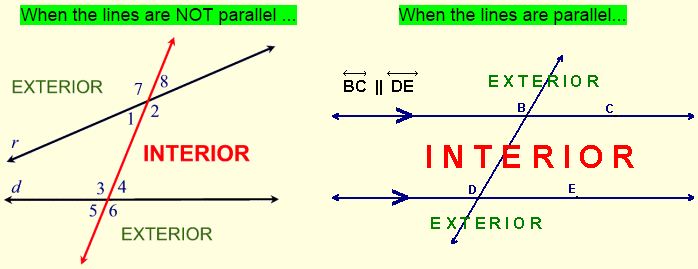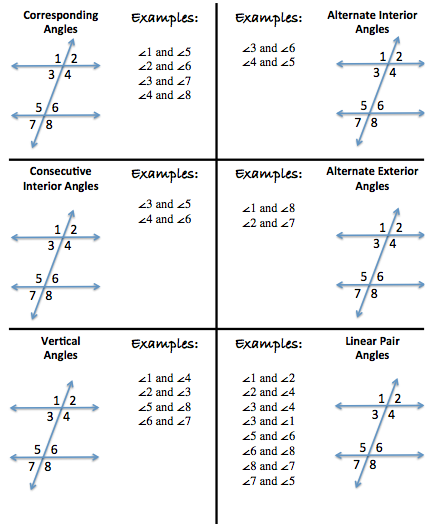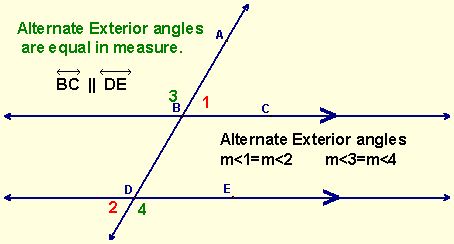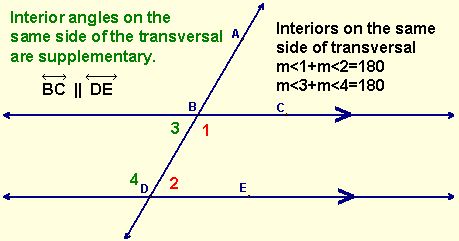Angles with Parallel Lines
A transversal is a line that intersects two or more lines (in the same plane). When lines intersect, angles are formed in several locations. Certain angles are given “names” that describe “where” the angles are located in relation to the lines. These names describe angles whether the lines involved are parallel or not parallel.

Remember that:
the word INTERIOR means BETWEEN the lines.
the word EXTERIOR means OUTSIDE the lines.
the word ALTERNATE means “alternating sides” of the transversal.

The names “alternate interior angles”, “alternate exterior angles”, “corresponding angles”, and “interior angles on the same side of the transversal” are used to describe specific angles formed when lines intersect. These names are used both when lines are parallel and when lines are not parallel.

Let’s examine these angles, and other angles, when the lines are parallel.
When the lines are parallel:
Alternate Interior Angles (measures are equal)
The name clearly describes “where” these angles are located.
Look carefully at the diagram below:

Hint: If you draw a Z on the diagram, the alternate interior angles are found in the corners of the Z. The Z may also be a backward Z.

Theorem:
If two parallel lines are cut by a transversal, the alternate interior angles are congruent.
Theorem:
If two lines are cut by a transversal and the alternate interior angles are congruent, the lines are parallel.
When the lines are parallel:
Alternate Exterior Angles (measures are equal)
The name clearly describes “where” these angles are located.
Look carefully at the diagram below:

Theorem:
If two parallel lines are cut by a transversal, the alternate exterior angles are congruent.
Theorem:
If two lines are cut by a transversal and the alternate exterior angles are congruent, the lines are parallel.
When the lines are parallel:
Corresponding Angles (measures are equal)
Unfortunately, the name of these angles does not clearly indicate “where” they are located. They are located:
- on the SAME SIDE of the transversal
- one INTERIOR and one EXTERIOR
- and they are NOT adjacent (they don’t touch).
(They lie on the same side of the transversal, in corresponding positions.)

Hint: If you took a picture of one corresponding angle and slid the angle up (or down) the same side of the transversal, you would arrive at the other corresponding angle.
Also: If you draw an F on the diagram, the corresponding angles can be found in the “corners” of the F. The F may be backward and/or upside-down.

Theorem:
If two parallel lines are cut by a transversal, the corresponding angles are congruent.
Theorem:
If two lines are cut by a transversal and the corresponding angles are congruent, the lines are parallel.
When the lines are parallel:
Interior Angles on the Same Side of the Transversal (measures are supplementary)
Their “name” is simply a description of where the angles are located.

Theorem:
If two parallel lines are cut by a transversal, the interior angles on the same side of the transversal are supplementary.
Theorem:
If two lines are cut by a transversal and the interior angles on the same side of the transversal are supplementary, the lines are parallel.
Of course, there are also other angle relationships occurring when working with parallel lines.
Vertical Angles (measures are equal)
Vertical angles are ALWAYS equal, whether you have parallel lines or not.
Refresh your memory using the diagram below:

Theorem:
Vertical angles are congruent.
Angles forming a Linear Pair:
(Adjacent Angles creating a Straight Line) (measures are supplementary)
This is an “old” idea about angles revisited. Since a straight angle contains 180°, these two adjacent angles add to 180. They form a linear pair. (Adjacent angles share a vertex, share a side, and do not overlap.)

Theorem:
If two angles form a linear pair, they are supplementary.
